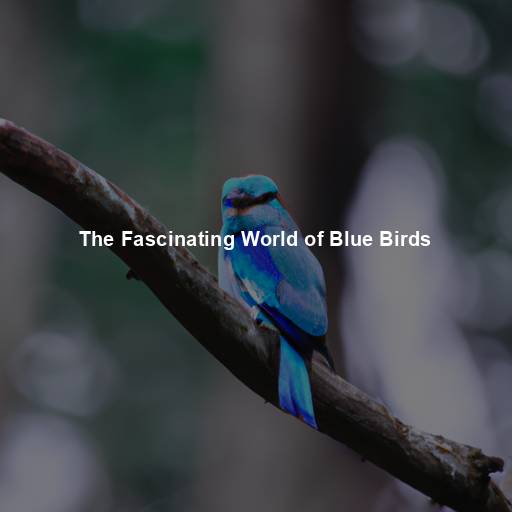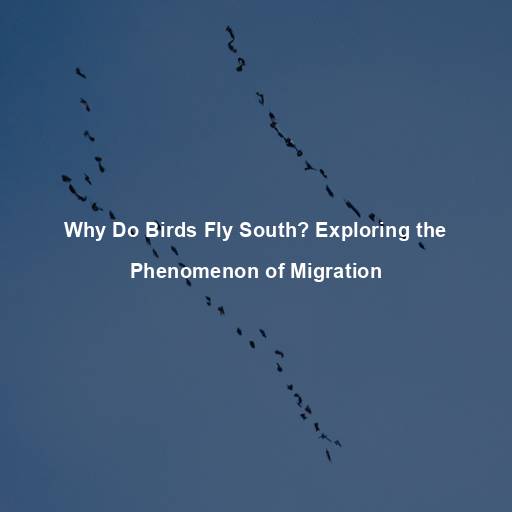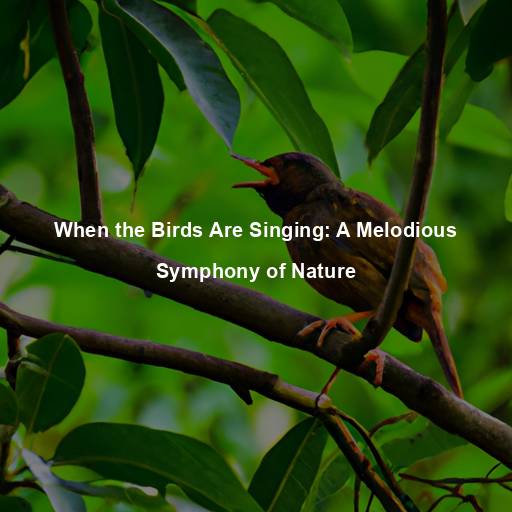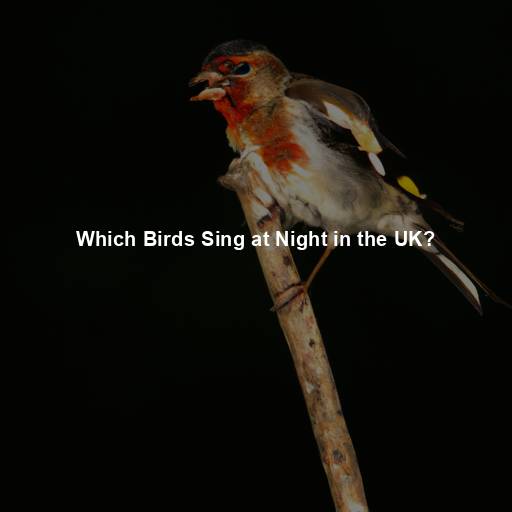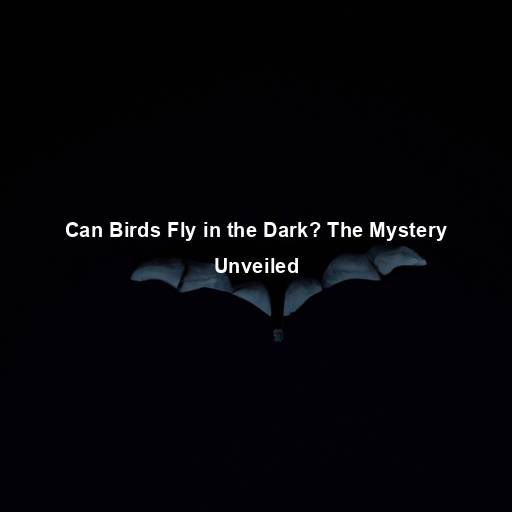The Fascinating World of Blue Birds
Last Updated on November 15, 2023 by Evan
Throughout history, the allure of blue birds has captivated our hearts with their mesmerizing allure. Their radiant feathers create a spellbinding contrast against the lush greens of their surroundings, leaving us in awe of their beauty. But have you ever wondered which birds possess this remarkable hue? Unraveling this enigmatic question, our all-inclusive guide embarks on a whimsical exploration of the delightful array of blue birds.
Contents [hide]
- 1 The Azure Splendor: Blue Jay
- 2 Symbolism and Cultural Significance
- 3 Conservation and Preservation
- 4 A Kaleidoscope of Blue
- 5 Beyond Blue Feathers: Understanding Bird Pigmentation
- 6 Blue Birds in Mythology and Folklore
- 7 The Enigmatic Blue Birds
- 8 The Science Behind Blue Plumage
- 9 Blue Birds and Human Culture
- 10 Appreciating the Blue Birds
- 11 FAQs: What Birds Are Blue?
- 11.1 What birds are known for their vibrant blue color?
- 11.2 How do birds get their blue color?
- 11.3 Are there any blue birds that are not actually blue?
- 11.4 Are all blue birds native to a specific region?
- 11.5 What purpose does the blue color serve in birds?
- 11.6 Are there any endangered blue bird species?
- 11.7 Can blue birds change their color?
The Azure Splendor: Blue Jay
In the realm of mesmerizing avian creatures, the Blue Jay (Cyanocitta cristata) reigns supreme as an unmistakable symbol of azure beauty. Adorned in a resplendent display of vivid blue feathers complemented by stark white and ebony embellishments, this enigmatic bird never fails to captivate onlookers’ gaze. Fabled to wander across the expanse of North America, the Blue Jay boasts not only remarkable intelligence but also an unmistakable vocal prowess, enchanting all who hear its distinctive calls and masterful mimicry. Acting as opportunistic omnivores, these birds embrace a versatile menu ranging from delectable seeds and nuts to tantalizing insects and, astonishingly, even diminutive vertebrates.
The Blue Emissary: Eastern Bluebird
With its striking combination of sky-blue feathers and a rusty breast, the Eastern Bluebird (Sialia sialis) effortlessly mesmerizes bird enthusiasts, becoming an enchanting symbol of hope and happiness. This small thrush species adds bursts of joy to our lives, with its preference for nesting in abandoned woodpecker holes or specially designed nest boxes. Fascinatingly, Eastern Bluebirds play a vital role in pest control and seed dispersal, as their diet consists mainly of insects and berries. Thanks to dedicated conservation efforts, their population has been safeguarded, prompting many avid supporters to create bluebird trails, providing the perfect haven for these captivating creatures.
The Tiny Marvel: Mountain Bluebird
Nestled amidst the sprawling expanse of North America’s majestic mountainous vistas, lies a creature that captivates the senses with its striking sapphire brilliance – the Mountain Bluebird (Sialia currucoides). With its song that veers between enchanting and evocative, this petite member of the thrush family gracefully dances through the sky, leaving trails of awe in its wake. Building its nests within tree hollows or custom-made abodes, these avian wonders nourish themselves on a hearty diet of insects. Yet, what truly astonishes is their ability to withstand the harshest of climates and embark upon arduous migratory expeditions – a testament to their unwavering spirit and remarkable adaptability.
The Tropical Gem: Blue-crowned Motmot
Venturing beyond North America, we discover the captivating Blue-crowned Motmot (Momotus momota). This stunning bird, found in the tropical regions of Central and South America, boasts a dazzling combination of blue, green, and turquoise plumage. Blue-crowned Motmots have a unique tail with distinctive racket-shaped feathers, which they use in courtship displays and territorial defense. These curious birds primarily feed on insects, small reptiles, and fruits, and play a vital role in seed dispersal within their habitats.
Symbolism and Cultural Significance
Blue birds have captivated human imagination for centuries and hold deep symbolism in various cultures and folklore. The color blue itself is often associated with tranquility, peace, and spirituality. Let us explore some of the symbolic meanings attributed to blue birds:
Hope and Happiness
There is an undeniable enchantment surrounding the presence of blue birds, especially the mesmerizing Eastern Bluebird. Deeply ingrained in folklore, these avian beauties hold the power to awaken a latent sense of hope and bliss. As they grace our surroundings, their mere appearance becomes a beacon of promise, infusing our souls with renewed vigor and an overwhelming sense of optimism for the future.
Freedom and Independence
In the rich tapestry of Native American traditions, there exists a profound reverence for blue birds as potent symbols of unbridled freedom and fearless independence. Embodied by their graceful flight across boundless skies, these enchanting creatures embody the unwavering quest for personal liberty and the audacious pursuit of breaking free from confinements. Whether perched majestically or soaring with breathtaking splendor, they ignite a deep yearning within our souls, reminding us to embrace the limitless potential that lies beyond perceived constraints.
Transformation and Renewal
Throughout various societies, there exists a captivating belief that the mere glimpse of a splendid blue bird holds immense power – an omen that foretells the advent of metamorphosis and rejuvenation. This vibrant creature has been revered as a symbol, urging individuals to fearlessly embrace the winds of transformation and embark upon a profound voyage of introspection and self-realization. Its ethereal presence instills a sense of wonder, inspiring souls to unveil their true potential and embrace the limitless possibilities that lie ahead.
Wisdom and Intuition
The enigmatic Blue Jay, known for its astute intelligence and expressive vocalizations, is unquestionably intertwined with the realms of wisdom and intuition. Its remarkable talent of emulating the calls of fellow avians stands as a testament to its remarkable adaptability and resourcefulness. A creature cloaked in boundless complexity, the Blue Jay perpetually bewilders observers with its manifold traits and enigmatic allure.
Conservation and Preservation
As we gaze in awe at the enchanting allure and profound symbolism bestowed upon the magnificent blue birds, it becomes imperative to confront the perplexing hurdles that hinder their existence. The disheartening truth is that these captivating creatures are confronted with a myriad of conservation challenges, such as the distressing loss of their natural habitats, the relentless force of climate change, and the perilous consequences of indiscriminate pesticide use. However, in our quest to ensure the preservation of these fragile avian wonders, we can play an indispensable role by diligently undertaking certain measures.
When it comes to fostering a thriving environment for blue birds, creating suitable nesting habitats takes center stage. By strategically installing nest boxes and preserving natural cavities, we can ensure that these beautiful creatures have safe spaces to breed and flourish. Providing them with the ideal nesting conditions not only supports their population but also allows us to witness their vibrant presence in our surroundings.
Creating a vibrant and eco-friendly environment by planting native trees and shrubs has proven to be an ingenious approach. By embracing the beauty of native plants, we not only enhance the diversity of our landscapes but also foster a sustainable habitat for a myriad of insects. These insects, in turn, play a crucial role in the delicate food web, providing nourishment for astonishing blue birds, adding a touch of mystique and wonder to our natural surroundings.
3. Reducing pesticide use: Opting for organic gardening practices minimizes the negative impact on blue bird populations and their ecosystems.
4. Supporting conservation organizations: Contributing to local and international conservation initiatives helps protect blue birds and their habitats.
By taking these small but significant steps, we can ensure the survival and well-being of these enchanting blue birds for generations to come.
A Kaleidoscope of Blue
As we conclude our exploration of what birds are blue, we are reminded of the immense diversity and wonder of the avian world. From the majestic Blue Jay to the enchanting Mountain Bluebird and the tropical beauty of the Blue-crowned Motmot, these blue birds continue to captivate our hearts and inspire us. Their vibrant plumage, melodious songs, and symbolic significance remind us of the delicate balance of nature and the interconnectedness of all living beings. So, the next time you catch a glimpse of a blue bird, take a moment to appreciate its beauty and the magic it brings to the world around us.
Another stunning blue bird that deserves our attention is the Indigo Bunting (Passerina cyanea). This small songbird, native to North America, boasts a brilliant blue plumage that seems to radiate in the sunlight. Male Indigo Buntings are particularly striking, with their vibrant blue feathers that can appear almost iridescent. The females, on the other hand, exhibit a more subdued brown coloration.
Breeding Habits and Migratory Patterns
Indigo Buntings are known for their breeding habits, as they engage in a behavior called “extra-pair mating”. This means that males may mate with multiple females, while females may also seek additional mates outside of their pair bond. This reproductive strategy allows for genetic diversity and increases the chances of successful reproduction.
As the breeding season unfolds, the enchanting melodies of male Indigo Buntings serenade the surroundings, igniting a vibrant burst of life in the air. These magnificent creatures, with wings outstretched, embark on awe-inspiring migrations that lead them to the captivating landscapes of Central America and the northern parts of South America. A sense of perplexity and wonder fills the atmosphere as these migratory birds journey across vast distances to find solace in their wintering grounds.
Conservation Concerns
While the Indigo Bunting population is currently stable, there are still conservation concerns to address. Habitat loss due to deforestation and the fragmentation of their preferred habitats pose significant threats to their long-term survival. Additionally, collisions with buildings and communication towers during migration can result in fatalities.
Conservation efforts focus on preserving and restoring suitable breeding habitats for Indigo Buntings, as well as raising awareness about the importance of bird-friendly practices such as reducing light pollution and implementing bird-safe infrastructure.
Beyond Blue Feathers: Understanding Bird Pigmentation
It’s truly puzzling how these magnificent birds manage to flaunt such striking blue feathers without having any actual blue pigments. Surprisingly, it turns out that their captivating hues are a result of a fascinating scientific phenomenon known as structural coloration. This intriguing process involves the intricate microscopic structures of their feathers reflecting and scattering light in a way that deceives our eyes, creating the illusion of vibrant blues and various other enchanting colors.
When it comes to blue birds, there’s an intriguing phenomenon happening within their feathers. These delicate creatures possess tiny air pockets that have the power to scatter and enhance blue light wavelengths, while simultaneously absorbing other colors. This captivating process of selective light scattering is what gives rise to the enchanting blue hues that grace our eyes.
Melanin and Carotenoids
Birds’ feathers contain two primary pigments that contribute to their coloration: melanin and carotenoids. Melanin is responsible for producing black, brown, and gray colors, while carotenoids create red, orange, and yellow hues.
In blue birds, the arrangement of melanin granules within the feathers interacts with light in a way that only the blue wavelengths are reflected, giving rise to their stunning blue appearance.
The Role of Structure in Blue Coloration
While melanin plays a role in creating structural coloration, the specific arrangement and composition of the feather structure are crucial in achieving the vibrant blue shades seen in birds like Blue Jays, Eastern Bluebirds, and Indigo Buntings.
The mesmerizing allure of blue plumage never ceases to astonish us. It’s truly perplexing how the intricate nanostructures hidden within the feathers work their magical charm, scattering and amplifying light in unimaginable ways. These delicate structures have the power to intensify blue wavelengths, creating a burst of vibrant color that captivates our senses. It’s a wonder of nature that continues to baffle and mystify us.
Blue Birds in Mythology and Folklore
From ancient tales to modern lore, the enigmatic blue birds have captivated our imaginations, entwined in a tapestry of myth and symbolism. They flutter through the pages of history, carrying myriad interpretations and cultural significance. Explore their mystical allure as we unravel the intriguing tales that have bestowed these winged wonders with legendary status.
The Bluebird of Happiness
The concept of the “Bluebird of Happiness” can be traced back to ancient Chinese mythology, where the bluebird represents joy, prosperity, and fulfillment. It has since become a symbol of happiness in many cultures around the world, often associated with positive emotions and contentment.
The Bluebird as a Messenger
In Native American folklore, blue birds are considered messengers, bridging the gap between the spiritual and physical realms. They are believed to carry messages from the spirit world to the living, offering guidance and protection.
The Bluebird as a Symbol of Love
Across various societies, the enigmatic allure of blue birds resonates as a captivating emblem of ardor and romanticism. Revered as emblems of unwavering devotion and profound connection, these captivating creatures embody the essence of loyalty and fidelity between soulmates. Their ethereal presence evokes a sense of wonder and mystery, enhancing the mystique surrounding the profound emotional bond shared between lovers.
The Enigmatic Blue Birds
As we delve into the world of blue birds, we uncover not only their physical beauty but also the intricate ecological roles they play and their rich symbolism in human culture. These captivating creatures continue to inspire awe and curiosity, reminding us of the boundless wonders of the natural world.
It is absolutely mesmerizing to witness the vast array of blue bird species that grace our world, from the awe-inspiring Blue Jay to the captivating Eastern Bluebird, as well as the Mountain Bluebird – a true symbol of resilience, the exotic Blue-crowned Motmot with its tropical allure, and the stunning Indigo Bunting that never fails to dazzle. Each of these magnificent creatures adds a distinct touch to the intricate fabric of life, bringing an unparalleled burst of vibrant blue hues and undeniable charm. Their presence in our surroundings truly leaves us in a state of awe and wonder, constantly reminding us of the perplexing beauty that exists in the natural world.
As we strive to protect and preserve these remarkable birds and their habitats, may our appreciation for their beauty and significance deepen, and may we continue to marvel at the kaleidoscope of blue that graces the skies and fills our hearts with wonder. ## The Mesmerizing Blue Birds of the World
Prepare to be spellbound by the mesmerizing allure of the azure aviators that have effortlessly enthralled mankind throughout the ages. As we embark on a sensational journey through the vivid tapestry of our planet, we shall unravel the enigmatic tales of these charismatic winged beings that grace the skies across continents and civilizations. Brace yourself for an expedition that unveils a kaleidoscope of dazzling blue plumage, each shade more bewitching than the last, accompanied by an enthralling assortment of peculiar traits and irresistible charms. Come, join us as we delve into the mystique of these extraordinary blue birds that epitomize nature’s enigmatic wonders.
The Azure Beauty: Azure-winged Magpie
One cannot help but marvel at the mesmerizing beauty of the Azure-winged Magpie (Cyanopica cyana). With its vibrant blue plumage delicately adorned with black and white accents, this avian wonder effortlessly captivates the eye. But there is more to this creature than meets the gaze. Revered for its wit and gregarious demeanor, the Azure-winged Magpie dances across the landscape in small clusters, engaging in a symphony of mischievous antics and captivating conversations that baffle the mind.
The Aquatic Marvel: Kingfisher
The fascinating Alcedinidae family, consisting of a diverse array of species, boasts a mesmerizing palette of blues gracing their feathery attire. These extraordinary avian creatures have gained a reputation for their uncanny fishing skills, effortlessly plunging into water bodies with impeccable precision to seize their aquatic prey. The alluring Common Kingfisher (Alcedo atthis) is a familiar sight across Europe and certain Asian regions, adorned with its vibrant blend of blues and oranges. Meanwhile, the Belted Kingfisher (Megaceryle alcyon) reigns in North America, captivating observers with its remarkable azure plumes and distinctive crested crown.
The Blue Aviator: Blue-winged Parrotlet
Native to South America, the Blue-winged Parrotlet (Forpus xanthopterygius) is a small parrot species that showcases beautiful shades of blue in its feathers. These social birds are highly active and often seen in flocks, displaying acrobatic flight patterns and emitting high-pitched calls. While they primarily feed on seeds and fruits, Blue-winged Parrotlets are known to indulge in occasional insect consumption.
The Oceanic Wonder: Blue-footed Booby
Roaming the tropical realms of the Pacific Ocean, a captivating creature known as the Blue-footed Booby (Sula nebouxii) has achieved an emblematic status. Nestled in the breathtaking landscapes of the Galápagos Islands, this avian marvel enchants onlookers with its surprising appearance. Departing from the expectations set by its name, the Blue-footed Booby adorns itself in a rich tapestry of brown plumage. Yet, it unveils its true eccentricity during the enchanting courtship rituals, when the males orchestrate a mesmerizing dance, utilizing their vibrant cerulean feet as instruments of allure.
The Science Behind Blue Plumage
Have you ever gazed in awe at the brilliant blue feathers of a majestic bird and wondered, “How on earth did they get that hue”? Well, my feather-loving friends, the answer lies in a whirlwind of mind-boggling biological processes and mesmerizing structural adaptations that leave us in a state of perpetual perplexity. By unraveling the intricate science behind these avian wonders, we can embark on a journey of profound understanding and an even deeper appreciation for the vibrant blues that grace our skies. So, prepare yourselves for an expedition into the bewildering world of feathery brilliance, where every burst of blue is a testament to the marvels of nature’s artistry.
Structural Coloration and Light Reflection
As mentioned earlier, the blue color of bird feathers is not generated by pigments but rather by structural coloration. The microscopic structure of the feathers interacts with light, selectively reflecting and scattering blue wavelengths while absorbing other wavelengths. This unique arrangement creates the vibrant blue hues we observe.
Tyndall Scattering and Melanin
Nature has an astounding way of weaving mesmerizing colors into the tapestry of its creations, and the enigmatic blue hues adorning the feathers of birds are no exception. Deep within the intricate architecture of these feathers lies a captivating secret: Tyndall scattering. This whimsical phenomenon, akin to the ethereal scattering dance of sunlight in our own atmosphere, produces the enchanting blue spectacle that graces the avian world. As if imbued with an artistic touch, the melanosomes, tiny pigment-filled organelles, intricately arrange themselves within these feathery structures, dictating the precise scattering of light and giving birth to the mesmerizing palette of blues that distinguishes different bird species.
Ultraviolet Reflectance
In addition to the visible blue color, some bird species also possess ultraviolet (UV) reflectance in their feathers. While humans cannot perceive UV light, birds can detect it, and the presence of UV reflectance plays a vital role in their communication, mate selection, and foraging behaviors.
Blue Birds and Human Culture
The allure of blue birds extends beyond their physical beauty. They have inspired artists, writers, and poets throughout history, becoming intertwined with human culture and symbolism.
Art and Literature
Blue birds have been a popular subject in art and literature, symbolizing various concepts such as freedom, happiness, and spirituality. They have appeared in paintings, poetry, and folktales, often representing a sense of wonder, hope, and the ethereal nature of the natural world.
Symbolic Meanings
In different cultures, blue birds have been associated with a range of symbolic meanings. They are seen as messengers of good fortune, symbols of love and fidelity, and representatives of divine connections. Blue birds continue to hold deep significance in folklore and spiritual beliefs around the world.
Appreciating the Blue Birds
As our awe-inspiring journey through the enchanting realm of blue birds comes to a poignant end, we are left mesmerized by their breathtaking allure and unyielding ecological significance. With their enchanting array of vibrant feathers and captivating repertoire of behaviors, these fascinating creatures effortlessly seize our imagination and amplify their cultural symbolism. With each passing moment, blue birds steadfastly cement their place in our hearts, reminding us of the indescribable wonder that exists within our world.
Let us cherish and protect these magnificent creatures by supporting conservation efforts, creating bird-friendly habitats, and fostering a deeper connection with the natural world. As we embark on this journey of discovery, may the presence of blue birds serve as a constant reminder of the profound interdependence between humans and the remarkable creatures that share our planet.
FAQs: What Birds Are Blue?
What birds are known for their vibrant blue color?
It’s a burst of vibrant blue that sets these avian wonders apart from the rest. From the Eastern Bluebird to the Mountain Bluebird, and the ever-majestic Blue Jay, these winged marvels have dazzled bird aficionados for ages. But wait, there’s more! The Indigo Bunting and the Turquoise-browed Motmot join the party, flaunting their mesmerizing shades of blue that leave us perplexed and in awe. Indeed, these feathered beauties have carved a niche in the avian kingdom, captivating our hearts with their unique and enchanting hues.
How do birds get their blue color?
Have you ever wondered how the vibrant blue color in a bird’s feathers comes to life? It’s a mesmerizing display of nature’s perplexing ways! Unlike traditional pigments that soak up particular wavelengths of light, birds owe their blues to a phenomenon known as structural coloration. Fascinatingly, the intricate microscopic structures within their feathers are expertly crafted to scatter and reflect only the magnificent blue light, creating an extraordinary visual burst of color that showcases their unique beauty.
Are there any blue birds that are not actually blue?
Who knew that the mesmerizing blue hues of certain avian wonders were nothing but an enchanting illusion? It turns out that while our eyes may perceive dazzling blues, these feathered friends are devoid of any blue pigment. Take the dashing male Eastern Bluebird, for instance, with its seemingly azure plumage. Closer inspection reveals that its feathers are actually sprinkled with melanin, which cleverly refracts light to create that breathtaking blue facade. And let’s not forget about the Purple Gallinule, whose sapphire-like appearance is merely a result of light playing tricks on its magnificent plumage. Who needs blue pigment when nature’s magic can effortlessly captivate us?
Are all blue birds native to a specific region?
No, blue-colored birds can be found in various regions across the globe. While some species, such as the Mountain Bluebird, are primarily native to certain parts of North America, others have a more widespread distribution. For instance, the Blue Jay can be found in eastern and central North America, while the Turquoise-browed Motmot is native to parts of Central and South America. Therefore, blue birds are not restricted to a specific region and can be discovered in different habitats worldwide.
What purpose does the blue color serve in birds?
In the mesmerizing world of avian wonders, the dazzling hues of vibrant blue serve as a multitool for our feathered friends. It’s not just about attracting a potential partner for a song and dance routine during the breeding season. Oh no! These azure feathers are like a holographic business card, revealing not only the bird’s impeccable health and superior genes but also shouting, “Look, I command this territory!” in a secret bird language that we mere humans yearn to understand. So, the next time you spot a blue beauty fluttering by, remember, there’s more to those ethereal shades than meets the human eye.
Are there any endangered blue bird species?
Yes, sadly, some blue bird species are currently endangered. For example, the Blue-throated Macaw, which possesses striking blue plumage, is critically endangered due to habitat loss and illegal pet trade. Another endangered species is the Hyacinth Macaw, known for its majestic blue wings. Conservation efforts and strict protection are essential to ensure the survival and recovery of these rare and beautiful blue birds.
Can blue birds change their color?
Contrary to popular belief, blue birds are not capable of magically morphing into different shades like their chameleon counterparts. The captivating color of a bird’s feather, even blue ones, is intricately woven into its genetic makeup and the very structure of the feathers themselves. These magnificent plumes are crafted with a special blend of pigmentation and unique structural composition that is responsible for their stunning hues. Although birds do undergo the process of molting and growing new feathers, the vibrant display remains steadfast, as the fresh plumage mirrors the inherent coloration of its predecessors.

